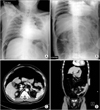Abstract
Colonic perforation during colonoscopy is a rare but lethal complication. Recently, it is usually managed with laparoscopic approach. Here we present our experience of single incision laparoscopic repair for sigmoid colon perforation during colonoscopy. A 57-year-old male patient presented with an acute sigmoid colon perforation event during diagnostic colonoscopy. Emergency operation was performed with transumbilical single incision laparoscopic exploration. The perforated site of sigmoid colon was primarily repaired with the curved endoscopic linear stapler. The patient was discharged after 5 days uneventfully. Single port laparoscopic repair is a safe and feasible method for the management of acute colonoscopic perforation during diagnostic colonoscopy.
Colonic perforation during colonoscopy is a rare but lethal complication. Recently, it is usually managed with laparoscopic approach [1234]. The minimal invasive laparoscopic technique has benefits such as less incision length, less postoperative pain, faster recovery, and reduced postoperative hospital stay [5]. Here we present our experience of single incision laparoscopic repair for sigmoid colon perforation during colonoscopy.
A 57-year-old male presented with an acute sigmoid colon perforation event during diagnostic colonoscopy. Endoscopic clipping repair was tried and emergency operation was per-formed with urgent identification of surgical abdomen com-bined with diffuse pneumoperitoneum on abdominopelvic com puted tomography (Fig. 1).
Transumbilical single incision laparoscopic exploration using glove port with 3 trocar channels (Sejong Medical Co., Paju, Korea) revealed a full-thickness tearing of the sigmoid colon which was primarily repaired with single firing of curved endo-scopic linear stapler (ECHELON FLEX, ENDOPATH, Ethicon, Somerville, NJ, USA) introduced via transumbilical port (Fig. 2). The suture line was checked intraluminally and acceptable patency without stenosis was found during intraoperative colonoscopy. No air or water leakage was noted.
The operation time was 55 minutes. There were no intra-operative complications, need for additional trocars, or open con version. A closed suction drain was applied into the left para colic gutter via transumbilical incision (Fig. 3). The patient was discharged after 5 days uneventfully (Supplementary material). Written informed consent was obtained from the patient.
Figures and Tables
Fig. 1
Radiologic findings of tension pneumoperitoneum. (A) Chest PA. (B) Plain abdomen. (C) Abdominopelvic CT, axial view. (D) Abdominopelvic CT, coronal view.

References
1. Hansen AJ, Tessier DJ, Anderson ML, Schlinkert RT. Laparoscopic repair of colonoscopic perforations: indications and guidelines. J Gastrointest Surg. 2007; 11:655–659.
2. Coimbra C, Bouffioux L, Kohnen L, Deroover A, Dresse D, Denoël A, et al. Laparoscopic repair of colonoscopic perforation: a new standard. Surg Endosc. 2011; 25:1514–1517.
3. Lohsiriwat V. Colonoscopic perforation: incidence, risk factors, management and outcome. World J Gastroenterol. 2010; 16:425–430.
4. Miranda L, Settembre A, Piccolboni D, Capasso P, Corcione F. Iatrogenic colonic perforation: repair using laparoscopic technique. Surg Laparosc Endosc Percutan Tech. 2011; 21:170–174.
5. Bleier JI, Moon V, Feingold D, Whelan RL, Arnell T, Sonoda T, et al. Initial repair of iatrogenic colon perforation using laparoscopic methods. Surg Endosc. 2008; 22:646–649.
SUPPLEMENTARY MATERIAL
Supplementary material can be found via http://astr.or.kr/src/sm/astr-93-284-s001.mp4.




 PDF
PDF ePub
ePub Citation
Citation Print
Print





 XML Download
XML Download